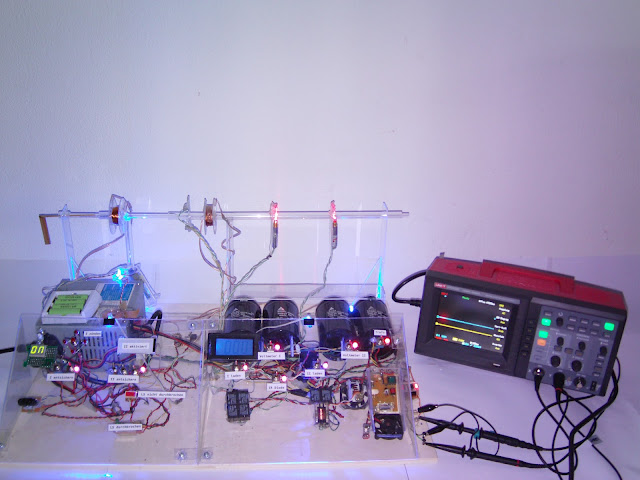
Coil guns use electromagnetic coils to propel a metal projectile. On the surface they may look rather complicated. But when you break down the concepts it’s pretty easy to learn. If you’ve ever thought of dabbling in this field this lengthy coilgun primer will be a great help.
The basic concept of a coilgun comes in three parts: the coil, the voltage source, and the switch that combines the two. In the build above you can see two spools of wire on the clear barrel of the gun. These make up a pair of accelerators which connect to those huge black capacitors supplying the voltage. The switch they used can’t really be seen but from the article we know it’s a Thyristor; a Silicon Controlled Rectifier (2N6504).
In the video after the break you can see these three parts coming together for a test firing. This is the first step in a longer journey. To achieve higher projectile velocities you must add coils, as in the image above. But spacing and timing quickly complicate the simple concept. But if you can work out all the kinks you end up with some pretty great hardware.
[youtube=http://www.youtube.com/watch?v=6cJM8oKiQYA]
















What bugs me is that everybody’s doing the same old same old coil gun, when it’s been proven time and time again that it’s not going to work very well because the coils are not fast enough and the projectile gets saturated, and the efficiency falls below measurable at any velocity faster than you could throw a rock with your bare hand.
Why won’t anyone try to do it the other way? Inductive linear acceleration doesn’t suffer from any of those problems.
Then build one and post it, Dax.
It’s on the drawing board.
ive got a boost converter that gets more than 375V and can give more than 150mA(need more capacitors to see the actual highest voltage).
The link to the video is not embedded!
Just FYI I have tons of these high voltage caps if anyone wants some or all. Just pay for shipping. If so msg me at tyler at gunsmokesports dot com.
I have some too, but I would prefer we learn how to _make_ our own. Sort of a craft’s movement for parts. I’m thinking also a miniaturized circuit that would combine the switch, capacitor, and timing circuits would be useful. Also, a switched-mode current multiplier. Sadly, this is heading into embargo areas… Think of the mostly unrelated example of nanosecond-programmable detonators. Gee what could those be used for? I’ll leave that as a homework assignment. O_o
It’s occurred to me that we also need to be looking into parametric arrays and such. One thing I’ve noticed is that these guns are generating incredible amounts of magnetic flux and… it’s being wasted on the time that the iron (for ferromagnetic mode devices) is not in the most efficient position. And this is without even bothering to do a computerized simulation – intuition tells me that if we’re not using the majority of the energy, then it’s going somewhere and logical thinking along with a little electronics math tells me that the somewhere is the very space surrounding the slug. We’re effectively creating DC where we need AC – don’t have to be a 21st-century Tesla to figure that out! Well DC in the wrong frame of reference – we want the slug to always be feeling constant acceleration, in theory. The idea mentioned above by Dax is good. Another is many, many small coils switched optically or something (self-calibrating or pre-calculated?). The one I’m wondering about is using something like parametric arrays.
The math behind parametric arrays is that you have multiple energy sources at a much higher-frequency and effectively rely on something akin to beat frequencies for the locally-delivered energy. It’s the idea behind ‘personal speakers’ that use ultrasound yet can be heard in the audible range and only in a certain area. What we need is better math and not just faster/higher-current switches. For the big guns like the US Navy wants, this is moot since rail guns and other plasma-based systems are the way to go with them. For those of us wanting a compact, but high-velocity accelerator, the coil gun is the way to go (in theory). Some people have done research into sabots, but it doesn’t solve the core limitation of the current coil gun theory and certainly doesn’t reduce weight. :/
Sounds like you and Dax should start up a kickstarter — and potentially quit your day jobs. :-)